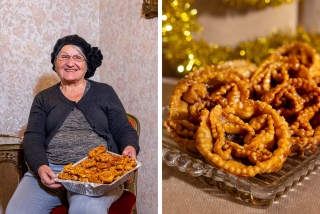Not your mom’s home ec
- Share via
Go back, through a universe of chalk dust and repeating bells, to a classroom outfitted with a line of squat stoves, a long table stacked with dry goods, a row of teenage girls mixing dough in dented bowls, writing down the equation of a good pie in notebooks tracked by ink and flour. It was 1980, and my freshman high school class was taking home economics, learning how to make a pot of stew, set a proper dinner table, bake and frost a cake, as the last months of the Carter administration clicked down.
But not long after that, my school and so many others discontinued the classes. And when I talked to my former home ec teacher recently, her raspy 75-year-old voice conflating the three decades since she taught me how to make soup, she wondered aloud where home economics had gone. It’s a common question.
But home ec has not disappeared, it’s changed, evolving into classes focusing on child development, nutrition, family health, food service and hospitality. It hasn’t been lost as much as translated. In 1994, the name of the course in most of the country was officially changed from Home Economics to Family and Consumer Sciences, or FCS, in an effort to dispel the impression that home ec was about teaching girls how to be housewives.
The number of secondary school students who take FSC classes has not substantially changed since the late 1950s, according to a 2004 national survey conducted by the National Coalition for Family and Consumer Sciences Education.
More than 5 million students were enrolled in secondary FCS education programs in the 2002-03 academic year, the study found, or about 25% of all students, almost the same percentage cited in a 1959 Department of Health, Education and Welfare study.
In fact, in California, home ec is still called home ec; it’s the only state in the nation that has kept the name. But whereas in the ‘60s and ‘70s, classes were composed entirely of girls and the curriculum focused on traditional homemaking, today they’ve evolved, says Patricia Scott, home economics teacher expert for the Los Angeles Unified School District, herself a longtime home ec teacher. “The name is still home economics; it’s still around. But they’re not the traditional programs; they’re more specialized.”
Now the classes, all electives, might be International Foods, Catering or Food Service and Hospitality Careers; they’re taught in 38 of the 60-plus LAUSD high schools and at least one middle school. In the 2007-08 school year, 4,650 LAUSD students took food-related home ec classes.
“I think programs like [those on] the Food Network have made it more trendy,” Scott says. “They’ve made a difference in the image.” The home ec program is one of the most popular in the district.
But within this upbeat picture is something of a disconnect. Home ec and FCS programs are overwhelmingly electives, determined state by state, always under threat of budget cuts and frequently recalibrated to fit an individual school’s needs, student demographics and teacher ideology. (“Wait, it may be under phys ed,” said one teacher at a local private secondary school when asked if they taught home ec.)
And although today’s flexible curriculum results in some remarkable success stories, it can also mean that basic cooking skills can get lost, translated into after-school specials, trade classes or boutique electives if they’re not ignored altogether. And if home ec is ignored or replaced by more academic classes, then learning how to cook, something that was once routinely taught at home, is now often not taught at all.
“All of what we teach is used every day,” says Erevetta Marzette, who’s been teaching home ec at Dorsey High School since 1989, and who runs one of LAUSD’s most successful culinary arts programs.
She and Scott agree that making home ec a required class is something they’d like to see. “If not a career, the kids need life skills,” says Marzette, who adds that most of the teenagers who come into her classroom do not know how to cook.
Making home ec compulsory is one thing that Alice Lichtenstein, a nutrition scientist at Tufts University and the co-author of a May commentary in the Journal of the American Medical Assn. titled “Bring Back Home Economics Education,” emphasized in a recent telephone conversation.
Lichtenstein cites the alarming rise in pediatric obesity and the poor diets of American adolescents, including an overreliance on packaged and fast food, as major issues of concern.
“I’m just talking about basic cooking skills,” Lichtenstein says. “The only way to really ensure that more kids get this type of instruction is to have it mandatory.”
--
Mom’s chocolate chip cookies
Total time: 45 minutes, plus cooling time
Servings: Makes 2 dozen cookies.
Note: This recipe comes from my mother, who was a home ec teacher. It’s the one she taught me and my sister, and our friends from high school -- all of whom would gather in our kitchen after school. She added the oatmeal because it was a Quaker school. My mother made these cookies with Crisco and generic bags of chocolate chips. I use unsalted butter and coarsely chopped Valrhona chocolate (71%) for the chocolate chips. These are big cookies; if you want smaller ones, simply decrease the amount of dough spooned out and bake for a shorter period of time.
1 cup (2 sticks) unsalted butter
3/4 cup white sugar
1 cup dark brown sugar
2 eggs
2 teaspoons vanilla extract
2 1/2 cups (10.6 ounces) flour
1 1/4 teaspoons kosher salt
1 teaspoon baking soda
1 cup old-fashioned rolled oats, preferably Quaker
3 cups (14 ounces) semi-sweet chocolate chips or coarsely chopped chocolate
1. Heat the oven to 350 degrees.
2. In the bowl of a standing mixer, mix the butter and sugars on medium speed until very well combined, about 1 minute. Add the eggs, one at a time, and the vanilla and mix until combined.
3. Add the flour, salt and baking soda directly into the bowl and mix on medium speed until well combined, about a minute. Scrape the sides of the bowl and make sure that the dough on the bottom is mixed too. Add the oats and the chocolate and mix it up briefly, until combined. At this point, you can refrigerate the dough or bake the cookies immediately.
4. Line trays with parchment paper and spoon out big balls of dough, about one-quarter cup, onto the parchment. Using your fingers, squash the balls down a little. Because these are big cookies and they’ll spread during backing, put 6 balls of dough on each tray.
5. Bake the cookies until they just start to brown around the edges, rotating the trays halfway so they bake evenly, about 15 minutes. Remove the cookies to a rack to cool. Repeat with all of the cookie dough. If you don’t want to bake them right away, or have time to bake only some of them, the dough will keep, well-wrapped, for a few days in the refrigerator. Once baked, the cookies will keep for up to 4 days in an airtight container or for up to a month frozen.
Each cookie: 272 calories; 3 grams protein; 38 grams carbohydrates; 2 grams fiber; 13 grams fat; 8 grams saturated fat; 38 mg. cholesterol; 24 grams sugar; 122 mg. sodium.
More to Read
Sign up for Essential California
The most important California stories and recommendations in your inbox every morning.
You may occasionally receive promotional content from the Los Angeles Times.











